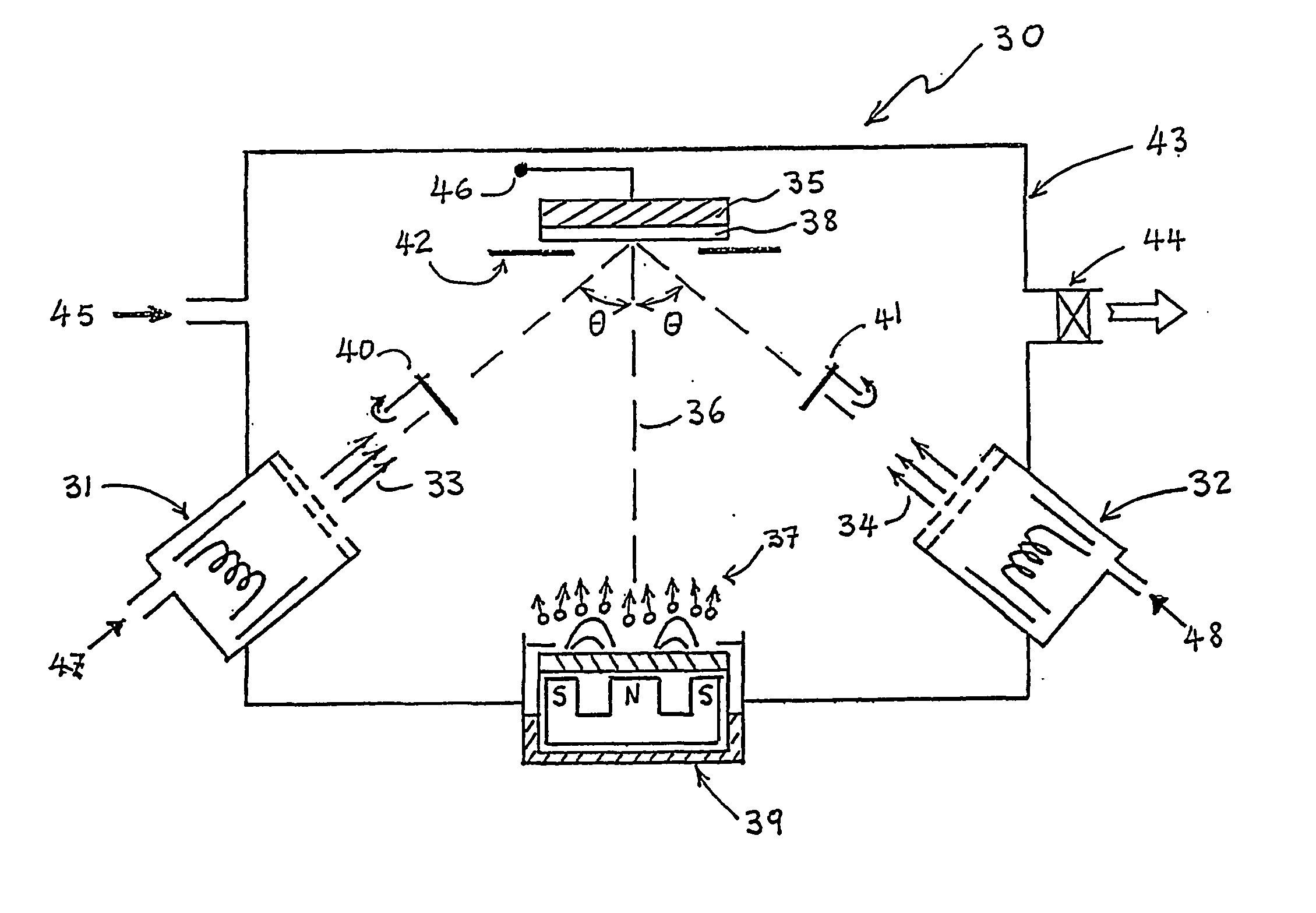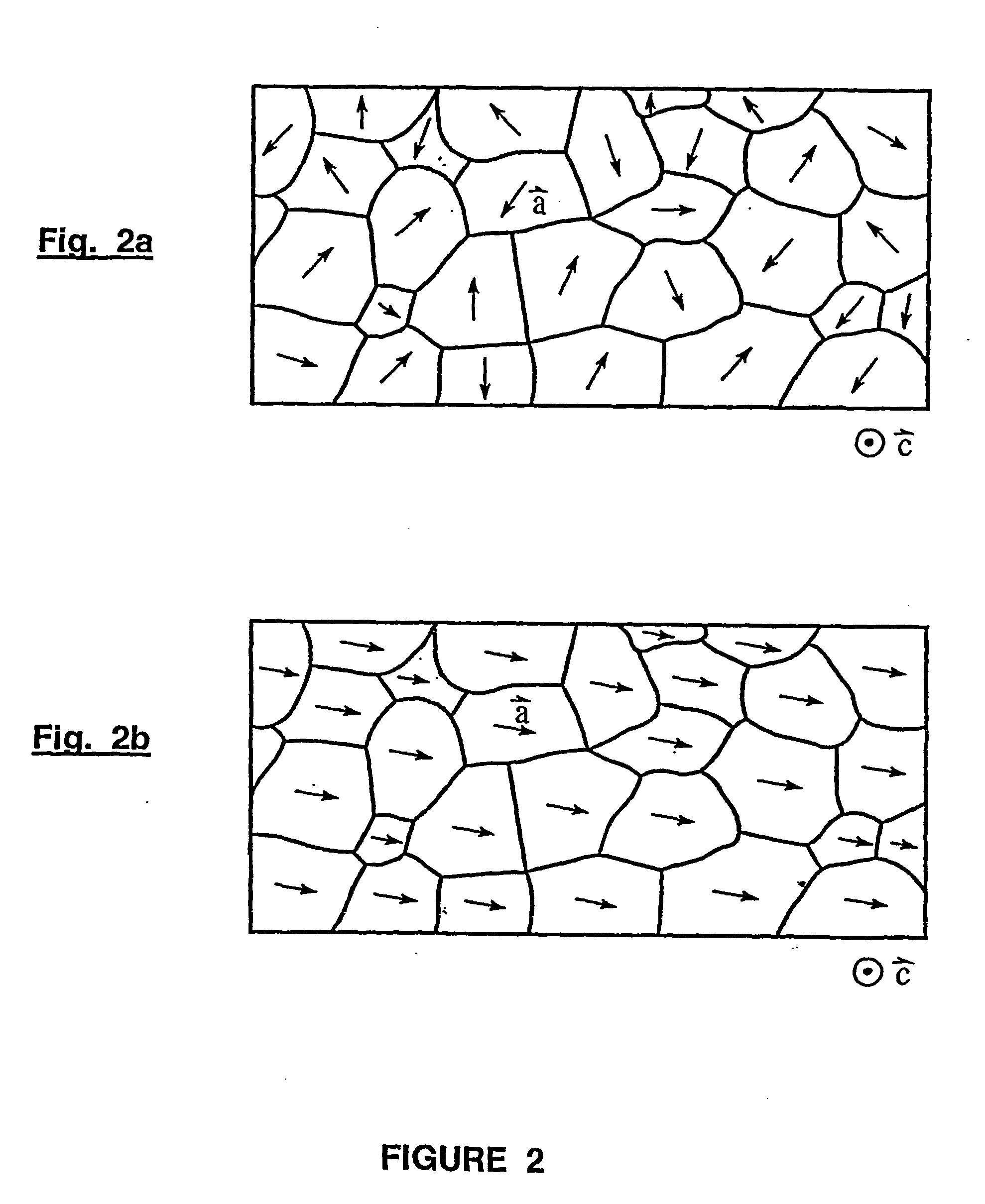Process and apparatus for producing cystalline thin film buffer layers and structures having biaxial texture
a technology of buffer layers and cystalline, which is applied in the direction of crystal growth process, polycrystalline material growth, superconductor devices, etc., can solve the problems of limiting the effective rate at which biaxial buffer layers are produced, not having the mechanical flexibility and strength needed to scale up the technology for commercial electric power applications, and high cost of single crystal substrates
- Summary
- Abstract
- Description
- Claims
- Application Information
AI Technical Summary
Benefits of technology
Problems solved by technology
Method used
Image
Examples
example 2
[0069] Biaxial CeO.sub.2 buffer layers were deposited onto Hastelloy substrates by DIBAD and IBAD (prior art) to compare the degree of biaxial alignment. FIG. 8 shows CeO.sub.2(111) x-ray pole figures and phi scans of the CeO.sub.2 buffer layers, where FIG. 8a relates to the CeO.sub.2 film deposited by IBAD, and FIG. 8b relates to the CeO.sub.2 film deposited by DIBAD. The deposition conditions were: Ar+ ions; angle of incidence .DELTA.=55.degree.; ion beam energy=300 eV; ion to atom arrival rate ratio=0.05. The phi scan peak of the IBAD CeO.sub.2 layer (FIG. 8a) yields .DELTA..phi.=32.degree. while that of the DIBAD CeO.sub.2 layer (FIG. 8b) yields .DELTA..phi.=27.degree.. These results clearly demonstrate that the DIBAD technique yields the sharper biaxial texture. In addition, the phi scans and pole figures of the DIBAD film have a better circular symmetry indicating a lower tilt of the out-of-plane or c-axis orientation compared to the IBAD film.
example 3
[0070] Biaxial YSZ buffer layers were deposited by the DIBAD method onto Hastelloy substrates as a function of ion beam energy. The films were bombarded during growth by Ar+ ions at angle of incidence .theta.=55.degree. and energy in the range from 100 to 400 eV. FIG. 9 shows the YSZ(111) x-ray phi scans and pole figures, where FIG. 9a is for beam energy of 100 eV, FIG. 9b is for beam energy of 200 eV, FIG. 9c is for beam energy of 300 eV, and FIG. 9d is for beam energy 400 eV. The results demonstrate that a sharp texture is obtained at the higher energies.
example 4
[0071] Biaxial YSZ buffer layers were deposited onto Hastelloy substrates by the sequential DIBAD method where each ion beam bombarded the film for periods of 10 to 60 minutes. FIG. 10 shows YSZ(111) x-ray phi scan and pole figures of a typical film 300 nm thick deposited for a total time of two hours where each ion beam bombarded the film for 30 minutes at a time. The other deposition conditions were: Ar+ ions; angle of incidence .theta.=55.degree.; ion beam energy=200 eV; ion to atom arrival rate ratio=0.04.
PUM
| Property | Measurement | Unit |
|---|---|---|
| angle | aaaaa | aaaaa |
| angle | aaaaa | aaaaa |
| energy | aaaaa | aaaaa |
Abstract
Description
Claims
Application Information
 Login to View More
Login to View More - R&D
- Intellectual Property
- Life Sciences
- Materials
- Tech Scout
- Unparalleled Data Quality
- Higher Quality Content
- 60% Fewer Hallucinations
Browse by: Latest US Patents, China's latest patents, Technical Efficacy Thesaurus, Application Domain, Technology Topic, Popular Technical Reports.
© 2025 PatSnap. All rights reserved.Legal|Privacy policy|Modern Slavery Act Transparency Statement|Sitemap|About US| Contact US: help@patsnap.com



